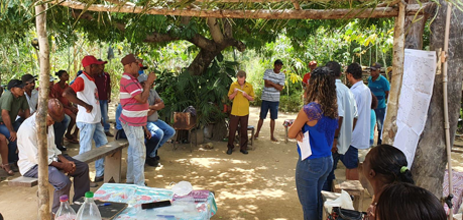With samba circle and "banquet”, IBGE carries out REPACs in quilombola areas in Bahia
April 11, 2022 13h47 | Last Updated: May 06, 2022 12h57
The 2022 Population Census will be the first one to bring specific data about the quilombola population, which will be key to implement public policies aiming at those people and their communities.
To explain the importance of the Census for Traditional Peoples and Communities (PCTs), Shirlene Lopes, area coordinator in the municipality of Santa Rita de Cássia (far 1,006 km from Salvador), and Ianna de Oliveira, sub-area Census coordinator, carried out two Census Planning and Monitoring Meetings (REPACs) in quilombola communities in the region.
On March 30 and 31, the IBGE representatives were, respectively, in the Area of Operational Interest (AIO) Santo Antônio, in the municipality of Santa Rita de Cássia, and in the AIO Buritizinho/Barra do Brejo, in the rural zone of Formosa do Rio Preto. Both meetings counted with local leaders, as well as health community agents and representatives of organizations that support rural workers and traditional communities.

REPAC in AIO Santo Antônio was outdoors
The REPAC in AIO Santo Antônio took place outdoors in the locality of Cadois, whereas the meeting in Buritizinho/Barra do Brejo was held in a local municipal school. With no access to digital resources, Lopes and Oliveira conducted oral presentations, using examples and facts of the local reality to streamline the understanding. In addition, printed maps of the municipalities and AIOs were taken to size the operation that will be carried out from August 1st onwards.
Oliveira tells that the meetings dealt with issues like the construction of AIOs by means of the Information Base on Enumeration Areas (BIOS) and the importance of hosting the enumerators and truly answering the questionnaires in order to better portray that locality.

Residents of AIO Buritizinho/Barra do Brejo watch the REPAC
Challenges, recognition and culture
In the presence of the IBGE representatives, the communities could deal with their distresses concerning local deprivations. Subjects like lack of electricity, water and bad access conditions were brought along.
AIO Santo Antônio also produced a deep discussion about the recognition of that community as quilombola. According to Lopes, many residents did not recognize them as such in spite of the historical matter.
“They were distressed with the possibility of being jeopardized in case they recognize themselves as quilombolas. One of them reported that he feared to lose his land and house, or that other persons take advantage of the community to obtain resources.”
After hearing this, the coordinators highlighted to the community that the IBGE works with self-declaration concerning the identification as quilombola and that every information provided is confidential, which helped them to be more confident.
When local culture began to be discussed, residents of both communities cheered up, brought their self-made instruments and introduced a samba circle. “We had to leave AIO Santo Antônio by 2 PM, though they extended the party until later. The issue of cultural representativity was a very spontaneous thing,” commented Lopes. Oliveira completed: “We perceived the pride and joy of residents in celebrating their habits.”

REPAC included lunch fixed by residents
Besides the presentation of music and dance, the IBGE representatives lunched what Oliveira considered a “delicious banquet”: beans with bones, rice, pumpkin picadinho and green beans farofa, most of them from the local farm.
“The inclusion of the quilombola population in the Census is a gain for Brazil. If we have to portray the country, it is key to unveil all our characteristics. After years fighting for their lives, we need to know their current life conditions,” concluded Oliveira.
